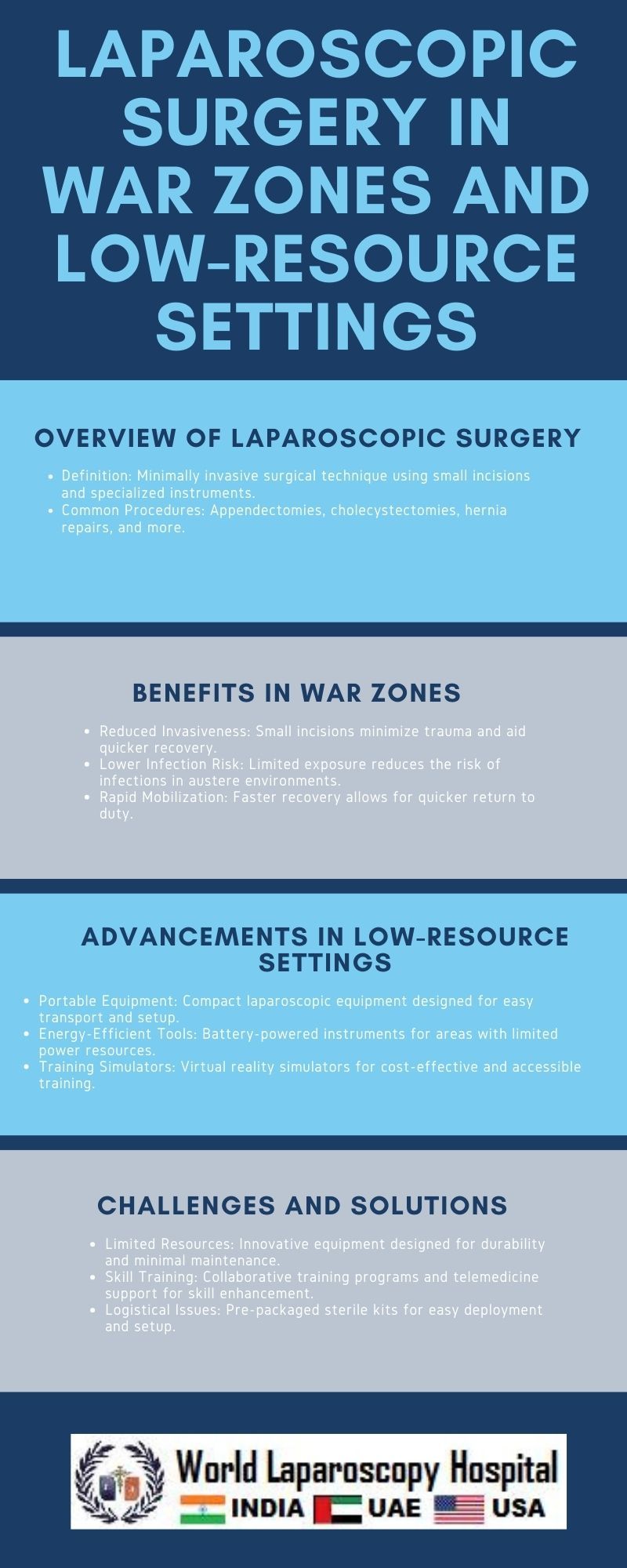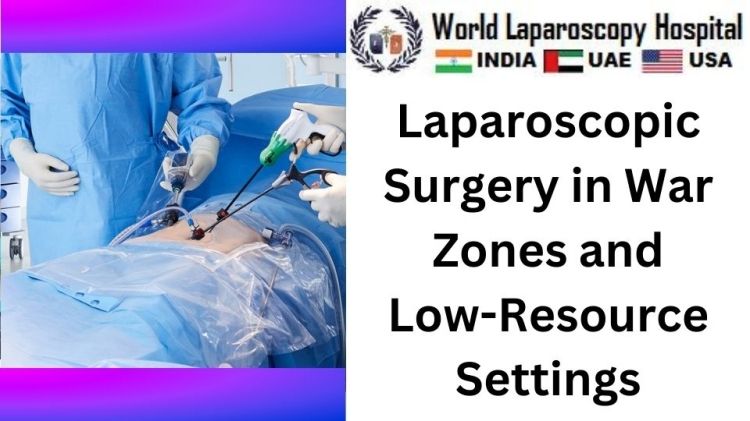Laparoscopic Surgery in War Zones and Low-Resource Settings
Laparoscopic Surgery in War Zones and Low-Resource Settings
Introduction:
In the midst of conflict and crisis, the need for efficient and effective medical interventions becomes paramount. One notable advancement in the field of surgery that has gained prominence in such challenging environments is laparoscopic surgery. Traditionally associated with well-equipped hospitals, laparoscopy's adaptability to war zones and low-resource settings has emerged as a transformative approach to providing essential surgical care.

Understanding Laparoscopic Surgery:
Laparoscopic surgery, also known as minimally invasive surgery, involves performing surgical procedures through small incisions with the aid of a camera. Unlike open surgery, which requires large incisions, laparoscopy utilizes specialized instruments and a laparoscope—a thin, flexible tube with a light and camera—to navigate and visualize the internal organs.
Benefits in War Zones:
Minimized Physical Trauma:
In conflict zones, injuries often result in complex wounds. Laparoscopic surgery's minimally invasive nature minimizes physical trauma compared to traditional open surgery, reducing the risk of infection and hastening recovery.
Faster Recovery Times:
The reduced size of incisions in laparoscopy translates to quicker healing times. In war zones, where immediate return to duty or civilian life is crucial, laparoscopic procedures offer a significant advantage.
Resource Conservation:
The scarcity of medical resources in conflict areas necessitates resource-efficient practices. Laparoscopy requires fewer supplies and shorter hospital stays, allowing medical teams to allocate resources more effectively.
Enhanced Precision:
Laparoscopic surgery provides surgeons with high-definition images of the surgical site, enabling precise and meticulous interventions. In situations where the margin for error is minimal, this technology proves invaluable.
Challenges in Low-Resource Settings:
Infrastructure Limitations:
Low-resource settings often lack the infrastructure necessary for laparoscopic surgery, including specialized equipment, trained personnel, and reliable power sources. Overcoming these challenges requires innovative solutions and adaptability.
Training and Education:
The expertise required for laparoscopic procedures is not always readily available in low-resource settings. Comprehensive training programs are essential to ensure that healthcare professionals can proficiently conduct these surgeries.
Cost Considerations:
While laparoscopic surgery can be cost-effective in the long run, the initial investment in equipment and training can be a barrier in resource-constrained settings. Strategic planning and support from international organizations are crucial in overcoming this obstacle.
Successful Implementation:
Several initiatives and case studies demonstrate the successful implementation of laparoscopic surgery in challenging environments:
Doctors Without Borders (Médecins Sans Frontières):
MSF has been at the forefront of providing surgical care in conflict zones. The organization has integrated laparoscopic techniques into its repertoire, showcasing the adaptability of minimally invasive surgery in austere environments.
Telemedicine and Remote Assistance:
Utilizing telemedicine, surgeons from well-established medical centers can provide guidance and support to healthcare professionals in low-resource settings, facilitating the adoption of laparoscopic techniques even in the absence of on-site experts.
Collaborative Training Programs:
Partnerships between international medical organizations, academic institutions, and local healthcare providers have proven effective in establishing training programs for laparoscopic surgery. These initiatives focus on building sustainable capacity within communities.
Future Considerations:
Technological Advancements:
Ongoing advancements in laparoscopic technology, such as the development of portable and affordable equipment, will further enhance the feasibility of these procedures in challenging environments.
Research and Data Collection:
Rigorous research is needed to assess the long-term outcomes and efficacy of laparoscopic surgery in war zones and low-resource settings. Collecting data on patient outcomes, resource utilization, and complications will contribute to evidence-based practices.
Global Collaboration:
International collaboration is essential to address the multifaceted challenges associated with implementing laparoscopic surgery in challenging environments. This includes sharing best practices, providing financial support, and fostering a collective commitment to improving surgical care worldwide.
Conclusion:
Laparoscopic surgery's applicability in war zones and low-resource settings marks a significant stride in the quest for resilient and adaptable healthcare systems. As technology continues to evolve and global collaboration strengthens, the integration of laparoscopy into the fabric of surgical care in adversity becomes not only feasible but essential. By overcoming challenges and leveraging innovative solutions, healthcare professionals can provide life-saving interventions where they are needed most, ultimately transforming the landscape of surgical care in the face of adversity.
Top
Introduction:
In the midst of conflict and crisis, the need for efficient and effective medical interventions becomes paramount. One notable advancement in the field of surgery that has gained prominence in such challenging environments is laparoscopic surgery. Traditionally associated with well-equipped hospitals, laparoscopy's adaptability to war zones and low-resource settings has emerged as a transformative approach to providing essential surgical care.

Understanding Laparoscopic Surgery:
Laparoscopic surgery, also known as minimally invasive surgery, involves performing surgical procedures through small incisions with the aid of a camera. Unlike open surgery, which requires large incisions, laparoscopy utilizes specialized instruments and a laparoscope—a thin, flexible tube with a light and camera—to navigate and visualize the internal organs.
Benefits in War Zones:
Minimized Physical Trauma:
In conflict zones, injuries often result in complex wounds. Laparoscopic surgery's minimally invasive nature minimizes physical trauma compared to traditional open surgery, reducing the risk of infection and hastening recovery.
Faster Recovery Times:
The reduced size of incisions in laparoscopy translates to quicker healing times. In war zones, where immediate return to duty or civilian life is crucial, laparoscopic procedures offer a significant advantage.
Resource Conservation:
The scarcity of medical resources in conflict areas necessitates resource-efficient practices. Laparoscopy requires fewer supplies and shorter hospital stays, allowing medical teams to allocate resources more effectively.
Enhanced Precision:
Laparoscopic surgery provides surgeons with high-definition images of the surgical site, enabling precise and meticulous interventions. In situations where the margin for error is minimal, this technology proves invaluable.
Challenges in Low-Resource Settings:
Infrastructure Limitations:
Low-resource settings often lack the infrastructure necessary for laparoscopic surgery, including specialized equipment, trained personnel, and reliable power sources. Overcoming these challenges requires innovative solutions and adaptability.
Training and Education:
The expertise required for laparoscopic procedures is not always readily available in low-resource settings. Comprehensive training programs are essential to ensure that healthcare professionals can proficiently conduct these surgeries.
Cost Considerations:
While laparoscopic surgery can be cost-effective in the long run, the initial investment in equipment and training can be a barrier in resource-constrained settings. Strategic planning and support from international organizations are crucial in overcoming this obstacle.
Successful Implementation:
Several initiatives and case studies demonstrate the successful implementation of laparoscopic surgery in challenging environments:
Doctors Without Borders (Médecins Sans Frontières):
MSF has been at the forefront of providing surgical care in conflict zones. The organization has integrated laparoscopic techniques into its repertoire, showcasing the adaptability of minimally invasive surgery in austere environments.
Telemedicine and Remote Assistance:
Utilizing telemedicine, surgeons from well-established medical centers can provide guidance and support to healthcare professionals in low-resource settings, facilitating the adoption of laparoscopic techniques even in the absence of on-site experts.
Collaborative Training Programs:
Partnerships between international medical organizations, academic institutions, and local healthcare providers have proven effective in establishing training programs for laparoscopic surgery. These initiatives focus on building sustainable capacity within communities.
Future Considerations:
Technological Advancements:
Ongoing advancements in laparoscopic technology, such as the development of portable and affordable equipment, will further enhance the feasibility of these procedures in challenging environments.
Research and Data Collection:
Rigorous research is needed to assess the long-term outcomes and efficacy of laparoscopic surgery in war zones and low-resource settings. Collecting data on patient outcomes, resource utilization, and complications will contribute to evidence-based practices.
Global Collaboration:
International collaboration is essential to address the multifaceted challenges associated with implementing laparoscopic surgery in challenging environments. This includes sharing best practices, providing financial support, and fostering a collective commitment to improving surgical care worldwide.
Conclusion:
Laparoscopic surgery's applicability in war zones and low-resource settings marks a significant stride in the quest for resilient and adaptable healthcare systems. As technology continues to evolve and global collaboration strengthens, the integration of laparoscopy into the fabric of surgical care in adversity becomes not only feasible but essential. By overcoming challenges and leveraging innovative solutions, healthcare professionals can provide life-saving interventions where they are needed most, ultimately transforming the landscape of surgical care in the face of adversity.
